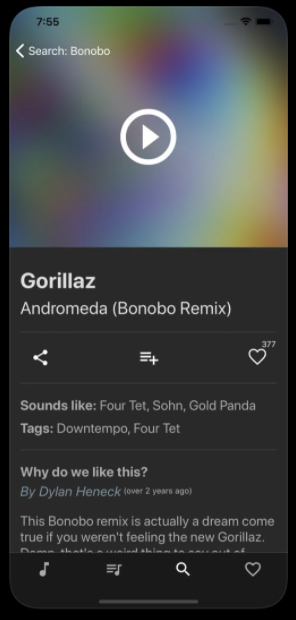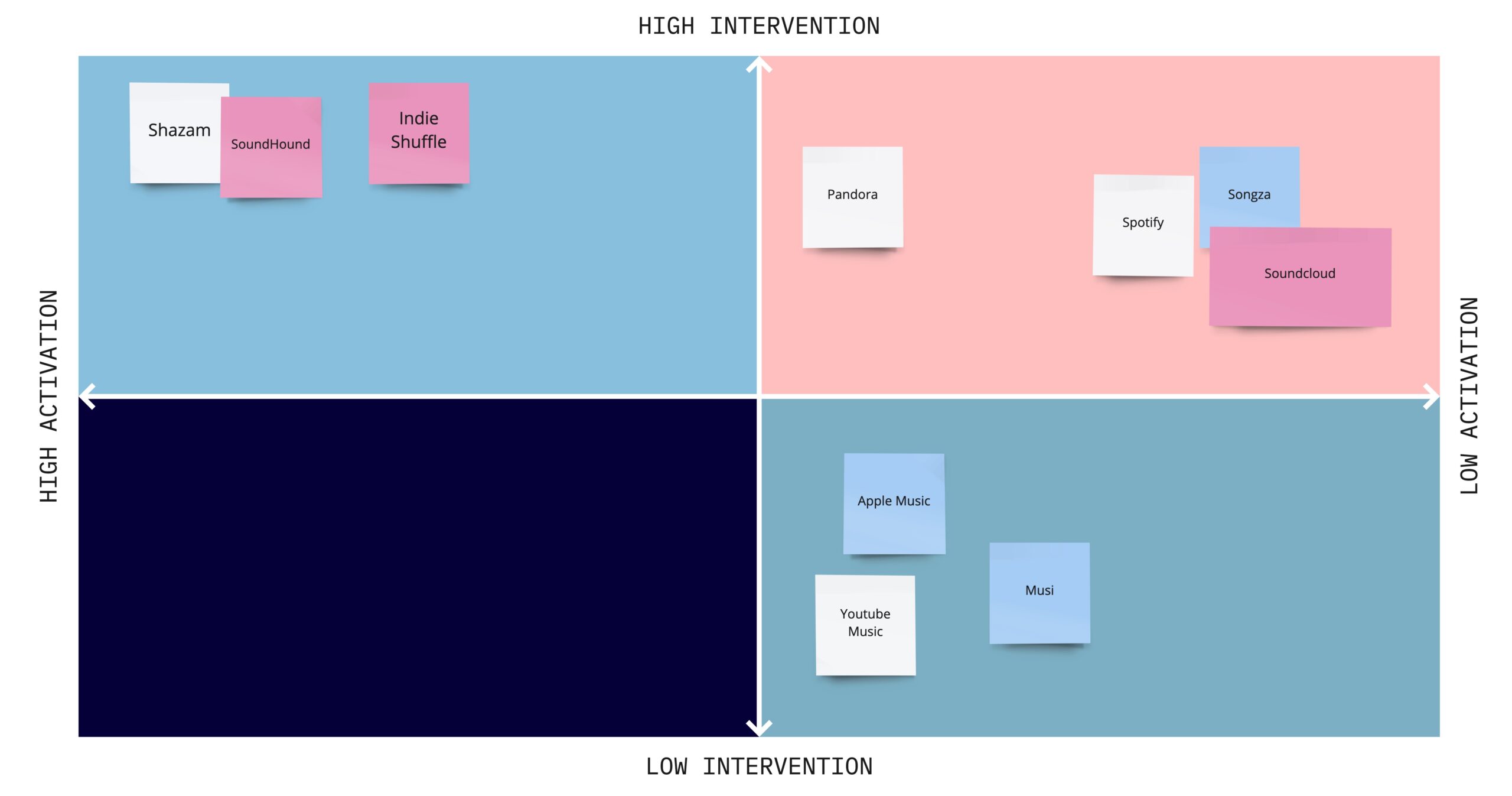This quarter, our team is researching habits around music listening and discovery. Namely, our goal is to design and build a product that helps users create habits in finding new music. Along with conducting literature reviews, our team analyzed multiple existing apps to learn more about the current solutions and compare them, in hopes of finding some key gaps or strengths to use in our own designs. In the section below, the individual analysis and synthesis of each app is presented, followed by an aggregate synthesis of all the apps.
Indie Shuffle
Indie Shuffle is a music blog that helps users discover new music and playlists. Their team of writers and curators are scattered around the world, tapping into the latest artists on a local and global level. Their playlists are carefully curated, offering hand-picked selections to fit many frames of mind or musical mood. This one differs from many other apps on this list in that it does not provide the music itself. It simply serves as a guide, and its entire mission is to put together what is essentially a list of recommendations. This could be seen as a drawback since a user has to go figure out a way to find the music, but on the other hand the team at Indie Shuffle probably places higher value in focusing on music curation, which helps increase the quality and number of new music recommendations.

SoundCloud
Soundcloud is one of the best places on the internet to discover music in its most raw, underground form. The process to upload music on SoundCloud is easier than anywhere else, so the barriers to entry are low. For that reason, there are a lot of up-and-coming and early stage artists that can be found or used to be on SoundCloud. SoundCloud also helps local music scenes thrive and helps expose users to their local artists. This is not to mention the large portion of SoundCloud that consists simply of people starting out to make music and showing it to people, which facilitates the creation of new music by making publishing more accessible. Of course, for these same reasons, SoundCloud also contains a lot of music that is either very niche, or lower quality production, which some users may find unappealing.
Spotify
Spotify is a digital music, podcast, and video service that gives users the ability to browse through and play millions of songs and other content from creators all over the world. Spotify operates under a fremium business model, where playing songs is free (with ads). Upgrading to premium allows you to build your own playlists, podcasts and more. Currently, Spotify boasts over 170 million premium users (leading all music services). Most people also argue that Spotify’s “cool” dark aesthetic and ease of use are strong contributors to its widespread popularity and adoption. It is incredibly easy to search for songs, queue them to be played, add them to a playlist or create a playlist from scratch. Additionally, on the content side, it arranges music and podcasts by album, which facilitate search and organization for users and creators. Finally, in my experience (and everyone I have interacted with) Spotify has a great algorithm for recommending music users might like based on what they have heard recently or what they have liked. One significant drawback of the platform is that by giving so many competing music selecting options (playlists, picked songs, friends music, discover weekly, Spotify radio, daily mixed, year wrapped, etc.) it is very easy for users to be overwhelmed and not know how to select the option that is best for them.
Apple Music
Apple Music is a music and video streaming service developed by Apple and exclusively for Apple product users. Users have access to millions of songs, podcasts and more, which they can stream to their device on-demand, or alternatively they can select an entire playlist to listen to. Although one of the main benefits of Apple music is its integration to other Apple devices, some would see this as one of its main drawbacks as well, since the service is exclusive to Apple devices (which could make sharing a hassle between friends). As with most Apple products/services, it is also praised for its intuitive design and “Apple compatible” aesthetic.
Pandora
Pandora is a leading music and podcast discovery platform, providing a highly-personalized listening experience to approximately 70 million users each month with its proprietary Music Genome Project® and Podcast Genome Project® technology. Pandora users can stream through its mobile app, the web, and integrations with more than 2,000 connected products. Pandora gives you a personalized listening experience that continually evolves with your tastes, as its primary functionality allows users to create stations from their favorite songs, artists, or genres as well as search for recommended stations based on mood or activity. When a user plays a given station by any of the previously mentioned searches, not only will they get music that suits their search criteria (from the specified artists, etc.), but they are also introduced to similar music outside of the search specifications. In this way, Pandora is the ultimate music streaming platform for new music discovery. A major drawback of Pandora is that users can’t make their own playlists or stations. Stations are completely made by the platform’s algorithms, so users do not have any autonomy over the stations they listen to beyond liking and disliking songs that come on. Additionally, Pandora does not have a very intuitive/user friendly UI (I worked here in the summer and many people complained about it).
Musi
Musi is a free music and radio app where users can bookmark and organize their favourite music videos, build infinite playlists, share with friends, and more. With the help of YouTube, users are granted access to a multitude of songs and music videos that they can add in their list by searching for the title of the song or artist. The app also curates its own playlists, such as “top hits” and “viral songs” so that users can explore even more new music. Musi markets itself as a means of creating “the perfect [music] library.” Through the functionality of sharing with friends and accessing platform-curated playlists, Musi makes music discovery easy. A major drawback of Musi is that you can not download music onto your device, so music listening can only occur when you have signal or wifi. The UI of Musi is very user friendly, but not especially aesthetically pleasing.
YouTube Music
YouTube Music is a music streaming service linked to YouTube. It allows users to search for and play music. It provides a series of tailored recommendations for users to browse for and stream music and media (including music videos). Its UI is greatly inspired by YouTube (the parent) which makes it easier for users to intuit the behavior of each component. It is possible to make playlists on YouTube Music although it does not seem like the primary focus of the platform; it is not obvious how one would create a playlist. YouTube boasts a great recommendation algorithm based on its Google collected data, leveraging every piece of content seen on the platform to build recommendations. One of the main drawbacks of the platform is the incessant ads before songs/music videos, which often throw people off the service. Additionally, there does not seem to be a good organization of content at least on the start page (arranged by genres, artists, etc.) which force the browsing to be more manual and painstaking compared to Spotify for example.
Shazam
Shazam is an app used to identify music (and other media) by capturing a short sample of the audio. The listening to a short sample of their audio. Shazam is extremely easy and quick to use, which is key as most people use Shazam in a rush. Users simply tap the Shazam button in the app home page or activate it through Siri. Once a song is found, the app displays additional information and sharing options.
Soundhound
SoundHound makes it simple to identify music playing around you. Whether you’re in the car or out and about — open the app, hit the big orange SoundHound button, let your phone listen for a few seconds, and Soundhound tell you exactly what’s playing! You can also hum the song stuck in your head.Soundhound also keeps track of your personal searches and allows you to refer back to them. Strengths: allows users to sing a new song/a song they can’t remember to get the title. Does show users new music. Does have a “most hummed” and “most loved” stories. Weaknesses: Specific scenarios of use, users would have to be exposed to unfamiliar music and not really have the title available to them. Available only on mobile devices. Seems like a straightforward UI (does have ads 🙄).

Songza
Songza has playlists that are made by music experts. Songza recommends playlists to its users based on time of day and mood or activity. Songza offered playlists for activities such as waking up, working out, commuting, concentrating, unwinding, entertaining, and sleeping. Users vote songs up or down, and Songza will adapt to the user’s personal music preferences. Users would find playlists not just based on artists, songs, or genres, but also based on themes, interests, and eras, such as “90s One-Hit Wonders”, or “Music of Fashion Week”. Strengths: does show users a bunch of new music. Weaknesses: lacks a social aspect to it. Users might not engage with it as much since all of the playlists might be too unfamiliar with the songs in the playlists. It is no longer available, sadly.
Matrix Mapping
Inspired by a prior blog post doing comparative analysis, we thought it would be helpful to generate a comparative matrix mapping activation vs. intervention. Here, activation is defined by how much effort users must put into discovering new music they like, and intervention is defined by how much the product prods the user to discover new music. We think this is an effective matrix for our research because music discovery is a positive habit (which is harder to induce change or intervene), so activation and intervention potential are crucial parameters.

Above is the mapping of all the analyzed products. We see a few themes here – first, there are no low intervention and high activation products – which is great! Furthermore, the highest intervention products (Shazam, SoundHound, and Indie Shuffle) have much higher activations: users must be listening to a song in real life to Shazam or SoundHound it, and Indie Shuffle doesn’t allow users to play songs. Lastly, the low activation products are split in intervention mainly due to their radio and recommendation algorithms, where the high intervention and low activation products not only provide robust music discovery, but also seamless saving of music into playlists.
An interesting takeaway here is that apps made a tradeoff between intervention and activation, where the highest intervention app, Indie Shuffle, had to trade off activation to provide great curated recommendations. We are interested in exploring how we could maintain extremely high intervention, such as the case of Indie Shuffle, but simultaneously provide low activation through creating a design and feature set that allows users to seamlessly act on finding new music, such as easy playlist creation or sharing.



